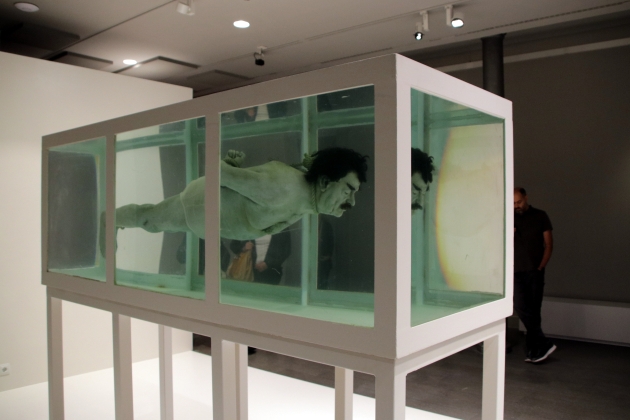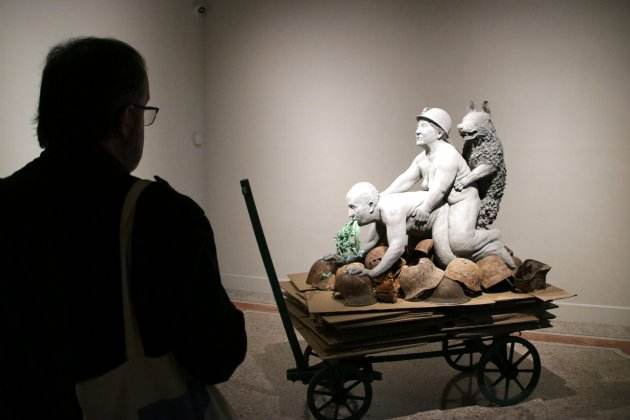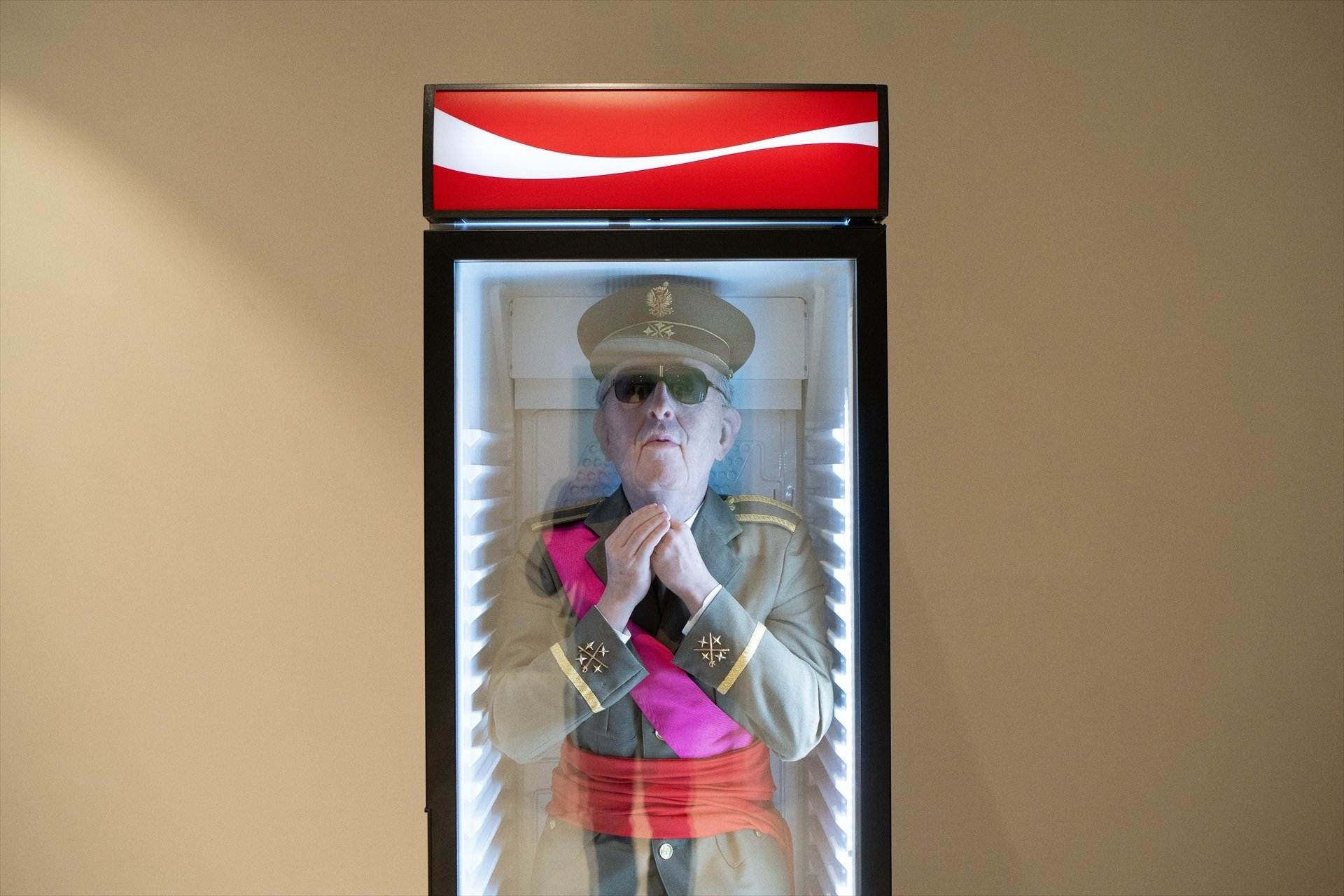Saddam Hussein gagged and drowned in formalin, in a glass case. Or the Generalísimo Francisco Franco standing, dressed in military finery and in an almost pleading position locked in a Coca-Cola cooler. Or the king emeritus Juan Carlos I with his hands tied and having sex in a representation sculpted by the Austrian Ines Doujak. These are just some of the unique pieces that the journalist and businessperson Tatxo Benet has been collecting over the last five years, fed up with seeing how these artistic dialogues did not find their place. It all started when, in 2018, the Madrid art show ARCO removed the work Presos políticos en la España contemporánea (Political prisoners in contemporary Spain) by Santiago Sierra and recently acquired by Benet, and at that point the light bulb flashed on on for the founding partner of Mediapro. Why not collect the censored works that had upset the powers that be and show them to the world?
Five years later, the Museu de l'Art Prohibit - the Museum of Forbidden Art - was born from that idea, located in Barcelona's Eixample, and aiming to advocate for freedom of expression through the exhibition of works from around the world that have suffered some type of censorship, whether political, social or religious, and which some have wanted to marginalize from the public debate. "It is a unique museum in the world," said its promoter. A proposal that, on the other hand, has not been easy: the first news about the initiative dates from 2020, and it has taken quite some time for the centre to become a reality. "It's a museum that has been created very quickly and that also took a lot of time to create, we've been talking and discussing how to do it for almost four years," he explained. Tatxo Benet's collection includes more than 200 pieces, but at the moment only 42 works can be seen permanently in this new artistic space, a collection that will be updated at intervals of around six months or a year. These are works that range from painting to engraving, sculpture or audiovisual works, some smaller and others larger, and which, in terms of their moment of creation, span from the Enlightenment to the 21st century.

The museum not only has an informative mission, but also aims to become a centre for censorship studies; a space that contemplates the multiple modalities of veto and confronts them with a dialogue between the piece and the viewer. Artists of international prestige come together in these corridors to denounce social, political or religious injustices; authors such as Ai Wei Wei, Andy Warhol, Robert Mapplethorpe, León Ferrari, Pablo Picasso and Gustave Klimt, all of them from different moments in time, showing that censorship has seldom stopped, and that interpreting universal themes still remains a reason for veto, such as female desire, sexual pleasure, the queer world, pederasty in the bosom of the church or the dictatorial ideologies of tyrants and despots.
Tatxo Benet: "We want people to understand that the works are not important for themselves, but for the story behind them"
Directed by Rosa Rodrigo and with Carles Guerra in charge of artistic direction, the Museum of Forbidden Art is a museum to amplify voices and tell stories, with 2,000 square metres of space dedicated to establishing a genuine conversation between artist and spectator and with the will that the each user's experience is fully personalized. So much so that the exhibition can be seen in 60 minutes or in 3 hours, because the importance does not reside only in the objects, but in the intrinsic stories that each piece tells. "We want people to understand that the works are not important for themselves, but for the story behind them; that's why we wanted to make a museum in which the explanation of the work was as relevant as the piece", added Benet, who assured that he continues to expand his personal collection.
Political prisoners work opened the door
Regarding the work focused on Spain's "contemporary political prisoners" exhibited at ARCO - which will not be found in this exhibition, as it is still on loan to the Museu de Lleida, Tatxo Benet affirmed that he bought it before it was censored. As such, it was the first work he bought with the idea of setting up a museum, although he did already begin to lay the foundations for the gaol that he would pursue shortly after: to obtain the maximum number of censored works possible and exhibit them in a great exercise of international anti-repression, also to discover the very thresholds of human tolerance. The first piece that Benet acquired with this express desire for criticism and reflection was Evermust, by Zoya Falkova, withdrawn from an exhibition in Kyrgyzstan by order of the culture ministry for being too pornographic and incompatible with national traditions, in this case, looking at a woman's body. The piece is a punch bag hanging from the ceiling that simulates the female figure.
Among the forty works that can be enjoyed at the centre's opening, the Museum of Forbidden Art hosts artistic proposals such as Andy Warhol's Mao, which was banned in China for allegedly depicting the late leader with feminine connotations; La civilización occidental y cristiana, by León Ferrari, vetoed by the current Pope Francis when he was bishop in Argentina for representing Christ nailed to a combat plane; Con Flores a María, by Charo Corrales, which shows the virgin looking up at the sky while touching her sex in a masturbatory position; Mc Jesus, by Jani Leinonen, in which the mascot Ronald McDonald is seen crucified; or the popular Not dresses for conquering / HC04 Transport, in which Juan Carlos I and the activist Domitilia appear having sex next to a German Shepherd. This work was part of the exhibition La bestia y el soberano (The Beast and the Sovereign), and in 2015 led to the resignation of Bartomeu Marí, then director of the MACBA. Admission to the general public is open as of Thursday, October 26th.


